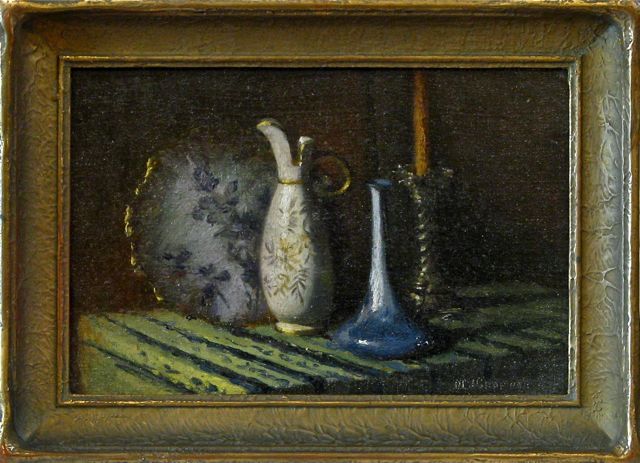Minerva Chapman
Minerva Chapman (1858-1947)
 Still Life by Minerva Chapman, 1910 – SOLD
Still Life by Minerva Chapman, 1910 – SOLD
Minerva Josephine Chapman was born on December 6, 1858, at “Sandbanks” in Altmar, New York. She began her education at the University of Chicago in 1875 and transferred to Mount Holyoke College from 1876-78. Chapman continued her studies in Chicago privately under Annie Cornelia Shaw from 1878-79, and at the Art Institute of Chicago with John H. Vanderpoel from 1880-86.
Chapman was in Paris by 1988 where she further studied at the Académie Julian until 1897, under Robert-Fleury, Bouguereau, Courtois, and Laurens. Her most influential teacher was Charles Lasar, who heavily influenced her bold, plein-air painting style, and introduced her to still life painting. Chapman was best known in Paris, where she spent most of her professional life, from 1887-1925.
In 1906 Chapman was among the first women, along with her friend Elizabeth Nourse and Mary Cassatt, to be elected a member of France’s official Salon of the Societe Nationale des Beaux Arts. She eventually became the first woman president of the International Art Union.
By 1900 Chapman had returned to Chicago, where she began painting watercolor miniatures on ivory. For the next few years she frequently traveled from Europe to Chicago. While in France in 1903, she studied with Emile Rene Menard who encouraged her small oil sketches. From 1915-17 Chapman lived in San Diego, until she returned again to Paris by 1918 where she remained until 1925. Chapman finally permanently settled in Palo Alto by 1925, where she remained until her death on June 14, 1947.
Chapman was best known for her portrait, still life and landscape painting, and used a broad post-impressionist technique in her oils. Her drawings in charcoal and chalk are equally impressive. Chapman’s expansive body of work is both free-spirited and conventional, continuously evolving as she refused to adhere to a single artistic expression. The accomplished painter embraced a variety of mediums over the fifty years of her professional career, and was well-respected in her own time. She was a major figure in the revival movement for painting miniatures on ivory, and a founding member of the miniature painting society.
Chapman has had retrospective exhibitions at the National Museum for Women in the Arts as well as numerous regional museums and art centers. She won many awards throughout her lifetime, and hundreds of her works have been shown in important international exhibitions. For Minerva Chapman art was a way of life.


 And many more
And many more